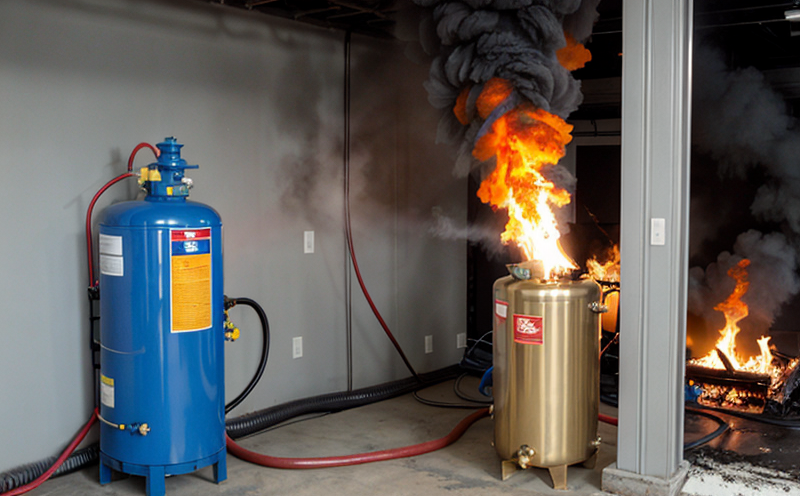UL 299 Fire Extinguishing System Testing
The UL 299 standard is a critical component in ensuring fire safety systems meet stringent performance requirements. This standard pertains to the testing of portable and semi-portable fire extinguishers, which are essential for combating small-scale fires. The testing process aims to assess how effectively these systems can deliver their intended fire-fighting capabilities under various conditions.
The UL 299 testing protocol is designed to simulate real-world scenarios that a fire extinguisher might encounter in its operational environment. This includes factors such as the type of fire, ambient temperature, and the presence of obstructions or other variables that could affect performance. The test involves subjecting the fire extinguishing system to specific conditions to evaluate its ability to extinguish flames effectively.
One of the key aspects of UL 299 testing is the evaluation of the extinguishing agent's effectiveness. This includes assessing how quickly and completely the agent can reduce or eliminate the flame. The test also examines other critical factors such as the discharge pattern, spray angle, and the time required for the agent to take effect.
Another important aspect of UL 299 testing is the evaluation of the structural integrity of the fire extinguisher during and after the discharge process. This ensures that the device remains intact and functional even under stress conditions. The test also checks for any potential hazards such as leaks or failures in the valve mechanism.
The UL 299 standard emphasizes both quantitative and qualitative assessments to ensure a comprehensive evaluation of fire extinguishing systems. Quantitative measures include the rate at which the flame is reduced, the amount of agent required to achieve this reduction, and the duration of the discharge process. Qualitative evaluations focus on the uniformity of the discharge pattern, the effectiveness of the spray angle, and the overall performance under different conditions.
Compliance with UL 299 is essential for manufacturers looking to ensure their fire extinguishing systems meet safety standards and are reliable in real-world scenarios. This standard helps maintain public confidence by ensuring that products can be trusted to perform as intended during emergencies. The testing process also provides valuable feedback to manufacturers, allowing them to identify areas for improvement and enhance product performance.
- Quantitative evaluations include the rate of flame reduction, amount of agent required, and discharge duration.
- Qualitative evaluations focus on discharge pattern uniformity, spray angle effectiveness, and overall performance under different conditions.
- The structural integrity assessment checks for leaks or failures in valve mechanisms during and after testing.
Why It Matters
Compliance with UL 299 is crucial for the safety and reliability of fire extinguishing systems. This standard ensures that these devices can be trusted to perform effectively in critical situations, thereby enhancing public safety.
The testing process helps manufacturers identify potential weaknesses or areas for improvement in their products. By adhering to this standard, companies can ensure that their fire extinguishing systems meet the highest industry standards and are capable of handling a wide range of fire scenarios.
Compliance with UL 299 also contributes to regulatory compliance, which is essential for businesses operating within specific jurisdictions. This ensures that products meet local and international safety regulations, reducing the risk of legal issues or recalls.
The testing process provides valuable insights into product performance under various conditions, enabling manufacturers to refine their designs and improve overall quality. This can lead to more effective fire suppression systems that are better equipped to handle real-world challenges.
Environmental and Sustainability Contributions
The UL 299 standard plays a role in promoting environmental sustainability by ensuring that fire extinguishing systems are both effective and safe. This standard helps reduce the risk of accidental fires, which can have significant environmental impacts. By improving fire safety, this standard contributes to minimizing damage to property and natural resources.
Compliance with UL 299 also supports sustainable practices by encouraging the use of environmentally friendly materials and processes in the manufacture of fire extinguishing systems. This helps reduce the overall environmental footprint of these products throughout their lifecycle.
The testing process itself contributes to sustainability by identifying inefficiencies or waste in the design and production of fire extinguishing systems. By optimizing product performance, manufacturers can reduce resource consumption and minimize waste generation.
Competitive Advantage and Market Impact
- Ensures compliance with international standards, enhancing market credibility.
- Identifies potential weaknesses in competing products, allowing for strategic improvements.
- Promotes the use of environmentally friendly materials and processes, appealing to eco-conscious consumers.
- Improves product performance under various conditions, leading to enhanced customer satisfaction and loyalty.





